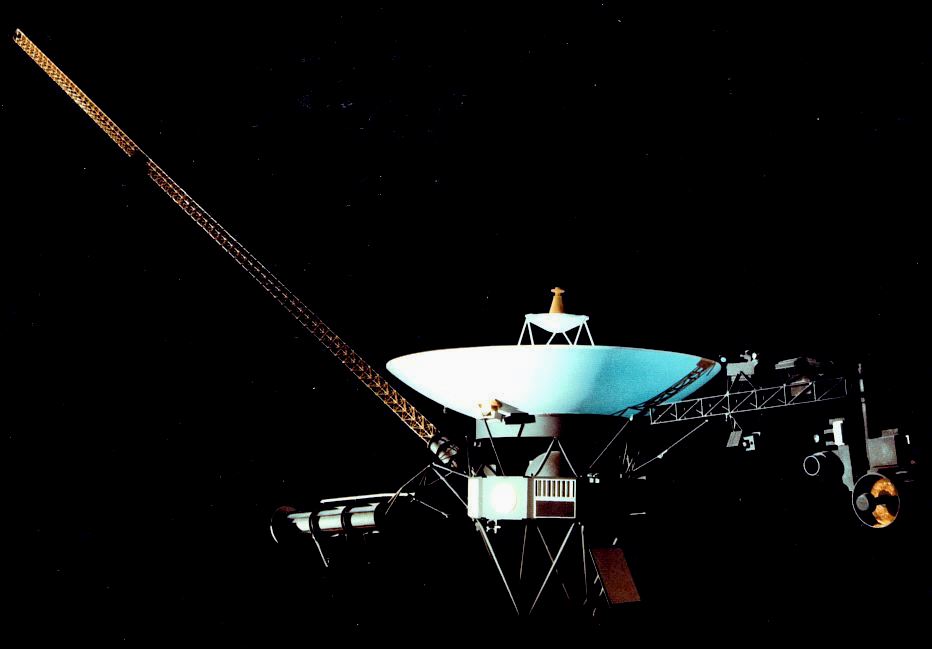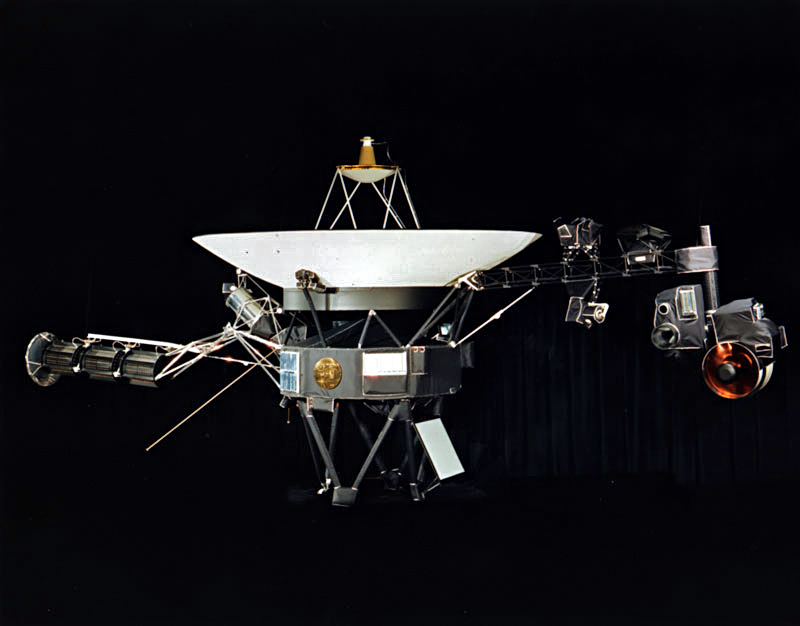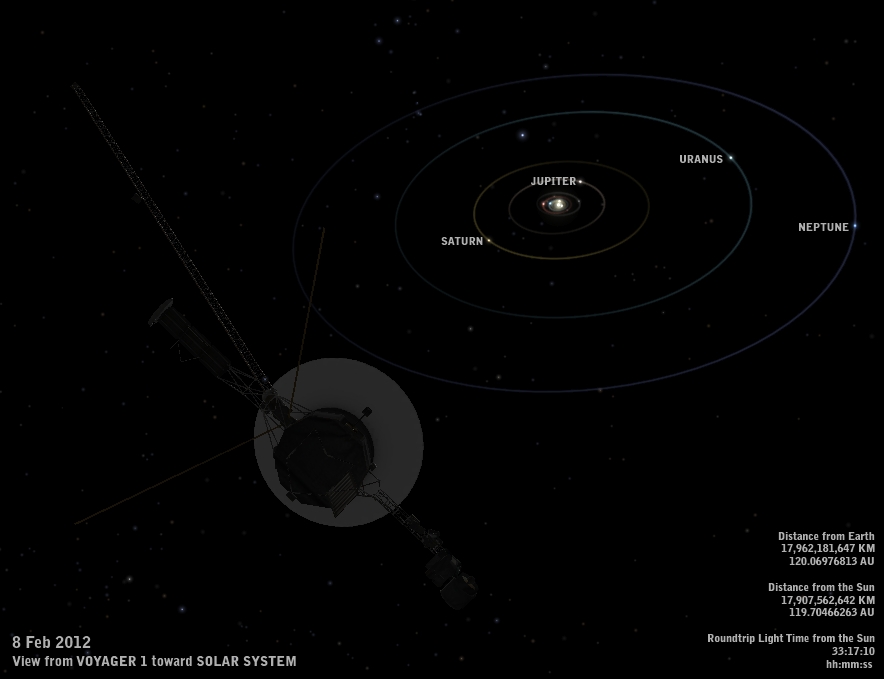Voyager 1
From Spacefaring
Voyager 1 is a space probe launched by NASA on September 5, 1977, as part of the Voyager program to study the outer Solar System and the interstellar space beyond the Sun's heliosphere. It was launched 16 days after its twin, Voyager 2. It communicates through the NASA Deep Space Network (DSN) to receive routine commands and to transmit data to Earth. Real-time distance and velocity data are provided by NASA and JPL. At a distance of 168.35 AU as of September 2025, it is the most distant human-made object from Earth. Voyager 1 is also projected to reach a distance of one light day from Earth in November of 2026.
1977 Website,
Wikimedia, Wikidata
MJS 77A; Mariner 77A; Mariner Jupiter/Saturn A; Outer Planets A; Voyager 77-2; Voyager I; Voyager1
-
Location: KML, Cluster Map, Maps,
- Voyager@ audio track 11 of Nostalgia for Infinity
- Voyager 1 Explores the Termination Shock Region and the Heliosheath Beyond@ scientific article
- Encounter with saturn: voyager 1 imaging science results@ scientific article published on April 1981
- Voyager 1 exited the solar wind at a distance of ∼85 au from the Sun@ scientific article published on 6 November 2003
- Voyager 1 exited the solar wind at a distance of ∼85 au from the Sun@ scientific article published on 6 November 2003
- Voyager 1 exited the solar wind at a distance of ∼85 au from the Sun@ scientific article published on 6 November 2003
- Voyager 1 exited the solar wind at a distance of ∼85 au from the Sun@ scientific article published on 6 November 2003
- Voyager 1 enters heliosheath at edge of solar system - Wikinews article (Spanish)
- Voyager 1 encounter with the saturnian system - scientific article (Q1860)
- Radio science with voyager at jupiter: initial voyager 2 results and a voyager 1 measure of the io torus - scientific article (Q1860)
- Galactic Cosmic-Ray Anisotropies: Voyager 1 in the Local Interstellar Medium -
- Voyager 1 signal received by radio amateurs - Wikinews article (English)
- Spectrophotometry of IO: Preliminary Voyager 1 results - scholarly article (Q1860)
- Voyager 1 Observes Low-Energy Galactic Cosmic Rays in a Region Depleted of Heliospheric Ions - scientific article published on June 27, 2013 (Q1860)
- Voyager 1 Observes Low-Energy Galactic Cosmic Rays in a Region Depleted of Heliospheric Ions - scientific article published on June 27, 2013 (Q1860)
- Search for the exit: Voyager 1 at heliosphere's border with the galaxy - scientific article published on 27 June 2013 (Q1860)
- Search for the heliosheath with Voyager 1 magnetic field measurements - scholarly article (Q1860)
- The Jupiter system through the eyes of Voyager 1 - scientific article (publication date: June 1979) (Q1860)
- Titan's surface and rotation: new results from Voyager 1 images - scientific article (Q1860)
- Plasma waves near saturn: initial results from voyager 1. - scientific article published on April 1981 (Q1860)
- Voyager 1 encounter with the Jovian system - scientific article (Q1860)
- Infrared observations of the Jovian system from Voyager 1 - scientific article (publication date: June 1979) (Q1860)
- Infrared polar brightening on Jupiter III. Spectrometry from the Voyager 1 IRIS experiment - (Q1860)
- Voyager 1 enters heliosheath at edge of solar system - Wikinews article (English)
- In situ observations of interstellar plasma with Voyager 1. - scientific article (Q1860)
- Voyager 1 enters heliosheath at edge of solar system - Wikinews article (Polish)
- Infrared images of jupiter at 5-micrometer wavelength during the voyager 1 encounter - scientific article published on June 1979 (Q1860)
- Voyager 1: energetic ions and electrons in the jovian magnetosphere - scientific article published on June 1979 (Q1860)
- Radio science investigations of the saturn system with voyager 1: preliminary results - scientific article published in April 1981 (Q1860)
- Voyager 1 planetary radio astronomy observations near jupiter - scientific article published on June 1979 (Q1860)
- Jupiter plasma wave observations: an initial voyager 1 overview - scientific article published on June 1979 (Q1860)
- The atmosphere of Titan: An analysis of the Voyager 1 radio occultation measurements - article (Q1860)
- Jupiter's Cloud Distribution Between the Voyager 1 and 2 Encounters: Results from 5-Micrometer Imaging - scientific article (Q1860)
- Plasma observations near jupiter: initial results from voyager 1. - scientific article published on June 1979 (Q1860)
- Extreme ultraviolet observations from voyager 1 encounter with jupiter - scientific article (Q1860)
- Magnetic Field Observations as Voyager 1 Entered the Heliosheath Depletion Region - scientific article published on June 27, 2013 (Q1860)
- Radio science with voyager 1 at jupiter: preliminary profiles of the atmosphere and ionosphere - scientific article published on June 1979 (Q1860)
- Magnetic field studies at jupiter by voyager 1: preliminary results - scientific article (Q1860)
- Voyager 1 in the foreshock, termination shock, and heliosheath - scientific article published in September 2005 (Q1860)
- Low-Energy Charged Particles in Saturn's Magnetosphere: Results from Voyager 1. - scientific article published on April 1981 (Q1860)
- Triangle for the entropic index q of non-extensive statistical mechanics observed by Voyager 1 in the distant heliosphere - scientific article (publication date: October 2005)
- Extreme ultraviolet observations from voyager 1 encounter with saturn - scientific article published on April 1981 (Q1860)
- Voyager 1 has reached interstellar space - scientific article published in Nature (Q1860)
- Infrared observations of the saturnian system from voyager 1. - scientific article published on April 1981 (Q1860)
- Energetic Charged Particles in Saturn's Magnetosphere: Voyager 1 Results - scientific article (Q1860)
| Type | Subtype | Date | Description | Notes | Source |
|---|---|---|---|---|---|
| commons | image | Transitional regions | Commons | ||
| commons | image | Voyager probe | Commons | ||
| commons | image | An image of Iapetus by Voyager 1, showing that it looks like Taijitu (Yin Yang Symbol) | Commons | ||
| commons | image | Voyager Instruments | Commons | ||
| commons | image | Photo of Voyager I | Commons | ||
| commons | image | Voyager 1 digital recorder | Commons | ||
| commons | image | Record is attached to Voyager 1 | Commons | ||
| commons | image | Voyager 1 reencapsulated | Commons | ||
| commons | image | Voyager 1 Saturn - 30737246655 | Commons | ||
| commons | image | Simulated view from Voyager 1 looking toward the Sun (EOSS) | Commons | ||









